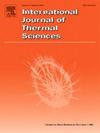Film heating heat transfer and effectiveness measurements for mainstream flow over a conical surface
IF 4.9
2区 工程技术
Q1 ENGINEERING, MECHANICAL
International Journal of Thermal Sciences
Pub Date : 2025-03-31
DOI:10.1016/j.ijthermalsci.2025.109902
引用次数: 0
Abstract
Adiabatic effectiveness and heat transfer coefficient measurements for fluid injection into the mainstream over a conical surface have been presented in this article. The axis-symmetric nature of the flow over the cone makes the heat transfer behaviour different from that observed for a flat surface, and dependent on the cone apex angles which were kept constant at 30° and 70° in the study. The injection angle was kept equal to 30° and 50° with respect to the surface of the cone and the blowing rate was varied between 0.3 and 2.5. The spatially resolved surface temperature measurements over the cone using an IR thermal camera were used to obtain the adiabatic effectiveness and heat transfer coefficient ratio values. The maximum values of the effectiveness for the 30° and 70° cones with 30° injection angle at locations along the centreline and in between the holes were 0.34, 0.22 and 0.24, 0.22 respectively at X/d = 5.5 for the lowest blowing ratio M = 0.3. The maximum increase in the heat transfer coefficient ratio was nearly equal to 30 % for both cones at 30° injection angle at the hole centreline at X/d =5.5 at the highest blowing rate M = 2.5. The effectiveness and heat transfer coefficient ratio experienced a reduced cross stream variation, compared to the flat surface case, for all cases studied.
主流流在锥形表面上的薄膜加热、传热和有效性测量
本文介绍了流体在锥面上注入主流的绝热效能和传热系数的测量。流动在锥体上的轴对称性质使得传热行为不同于在平面上观察到的传热行为,并且取决于锥体顶点角,在研究中锥体顶点角保持恒定在30°和70°。喷射角分别为30°和50°,吹速在0.3 ~ 2.5之间变化。利用红外热像仪对锥体表面温度进行了空间分辨,得到了其绝热效能和传热系数比值。在X/d = 5.5、最低吹气比M = 0.3时,30°锥和70°锥、30°喷射角在沿中线位置和孔间位置的有效性最大值分别为0.34、0.22和0.24、0.22。在X/d =5.5、最高吹气率M = 2.5时,两种锥筒在注入角为30°时,换热系数比的最大增幅接近30%。在所有研究的情况下,与平面情况相比,效率和传热系数比经历了减小的横流变化。
本文章由计算机程序翻译,如有差异,请以英文原文为准。
求助全文
约1分钟内获得全文
求助全文
来源期刊

International Journal of Thermal Sciences
工程技术-工程:机械
CiteScore
8.10
自引率
11.10%
发文量
531
审稿时长
55 days
期刊介绍:
The International Journal of Thermal Sciences is a journal devoted to the publication of fundamental studies on the physics of transfer processes in general, with an emphasis on thermal aspects and also applied research on various processes, energy systems and the environment. Articles are published in English and French, and are subject to peer review.
The fundamental subjects considered within the scope of the journal are:
* Heat and relevant mass transfer at all scales (nano, micro and macro) and in all types of material (heterogeneous, composites, biological,...) and fluid flow
* Forced, natural or mixed convection in reactive or non-reactive media
* Single or multi–phase fluid flow with or without phase change
* Near–and far–field radiative heat transfer
* Combined modes of heat transfer in complex systems (for example, plasmas, biological, geological,...)
* Multiscale modelling
The applied research topics include:
* Heat exchangers, heat pipes, cooling processes
* Transport phenomena taking place in industrial processes (chemical, food and agricultural, metallurgical, space and aeronautical, automobile industries)
* Nano–and micro–technology for energy, space, biosystems and devices
* Heat transport analysis in advanced systems
* Impact of energy–related processes on environment, and emerging energy systems
The study of thermophysical properties of materials and fluids, thermal measurement techniques, inverse methods, and the developments of experimental methods are within the scope of the International Journal of Thermal Sciences which also covers the modelling, and numerical methods applied to thermal transfer.
 求助内容:
求助内容: 应助结果提醒方式:
应助结果提醒方式:


